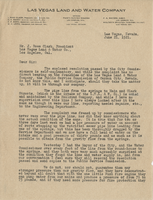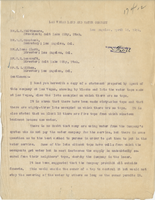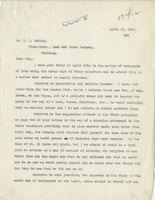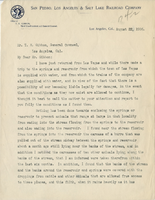Search the Special Collections and Archives Portal
Search Results

Telegram from Walter R. Bracken (Las Vegas) to W. H. Comstock and J. Ross Clark (Los Angeles), December 8, 1919
Date
Archival Collection
Description
The pipeline burst two weeks before and had flooded the entire rail yard and storehouse. Bracken asked if it could be fixed the same day.
Text

Letter from Walter R. Bracken (Las Vegas) to J. Ross Clark (Los Angeles), December 11, 1919
Date
Archival Collection
Description
Bracken informing Clark of the steps he had taken to prepare the railroad and the city of Las Vegas for the 24 hours without water that would be required to fix the damaged pipeline.
Text

Letter from Walter R. Bracken (Las Vegas) to J. Ross Clark (Los Angeles), January 17, 1920
Date
Archival Collection
Description
Bracken noticed that only 2600 feet of pipe was authorized to repair the pipeline from the Las Vegas Springs. He makes the case that it is best to replace the whole line as it would be cheaper in the long run.
Text

Letter from Walter R. Bracken (Las Vegas) to W. H. Comstock (Los Angeles), May 23, 1920
Date
Archival Collection
Description
Two hotels complained that they had no water pressure on their second floors, and Bracken discussed the possibility of purchasing a well to boost the pressure in the system.
Text

Letter from Walter R. Bracken (Las Vegas) to C. F. Miller (Los Angeles), May 19, 1920
Date
Archival Collection
Description
Discussion about drilling a well in the railyard. References the Sund, Conley, and Buol wells.
Text

Letter to W. H. Comstock (Los Angeles), May 25, 1920
Date
Archival Collection
Description
Letter probably from J. Ross Clark expressing skepticism that repairing the line will increase pressure. He was also wary of purchasing a well from someone else.
Text

Letter from Walter R. Bracken (Las Vegas) to J. Ross Clark (Los Angeles), June 21, 1921
Date
Archival Collection
Description
Bracken appraising Clark of a complaint by the City Commission to the Nevada Public Service Commission and its resolution.
Text

Letter from H. I. Bettis (Los Angeles) to C. O. Whittemore (Salt Lake City), W. H. Comstock (Los Angeles), J. Ross Clark (Los Angeles), W. H. Bancroft (Salt Lake City), and T. E. Gibbon (Los Angeles), April 12, 1906
Date
Archival Collection
Description
There were more lots in Las Vegas occupied than paid water connections, and the letter discusses the best method to get unauthorized users to pay.
Text

Letter to H. I. Bettis, April 13, 1906
Date
Archival Collection
Description
Bettis stating that prohibiting outside faucets would not solve the problem of unauthorized users, and would punish those who haven't given permission to neighbors who were using it anyway. It was also hard for owners to stand guard over their taps.
Text

Letter from C. O. Whittemore (Los Angeles) to T. E. Gibbon (Los Angeles), August 22, 1906
Date
Archival Collection
Description
Whittemore stating that the reservoir at the Las Vegas Springs should be covered and a pipeline run since the open water system was an epidemic and a lawsuit waiting to happen.
Text
